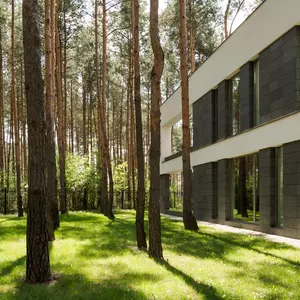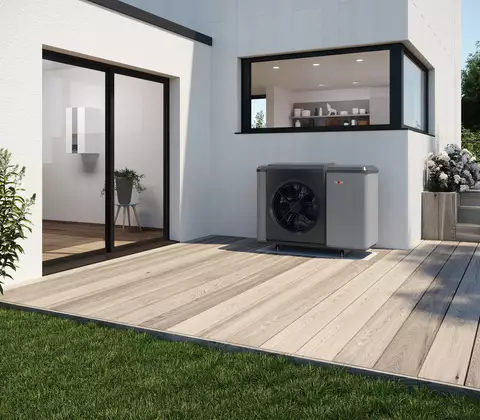
Heat pumps: Monoblock or split?
A comparison of benefits and drawbacks
When deciding to purchase a heat pump, building owners can choose between a single appliance (monoblock) or a two-part split version. Both systems have their benefits and drawbacks, particularly with respect to difficulty of installation and space requirements. The question of whether to go with a monoblock or split heat pump is a complex one that should be considered on a case-by-case basis depending on the conditions at hand. We will show you what is important when making this decision.
Air-to-water heat pump: Monoblock or split
Before we go into the specifics of the different designs, we will briefly explain the working principle of a heat pump. Regardless of which type of heat pump you use, they are always efficient heating systems that extract free environmental heat by consuming a small amount of energy in the form of electricity.
The heat pump works like an inverted refrigerator, extracting thermal energy from the ambient medium and routing it to the heating system in the building. There, the energy can be used for DHW heating and/or central heating backup. In the private sector, the primary energy sources used are the ambient air, groundwater and geothermal heat.
Since the initial investment is higher for water-to-water heat pumps and brine-to-water heat pumps (also known as a geothermal heat pumps), many building owners opt for air-to-water heat pumps. They have many plus points, particularly in terms of flexible installation. This can be a deciding factor when renovating existing buildings, for example.
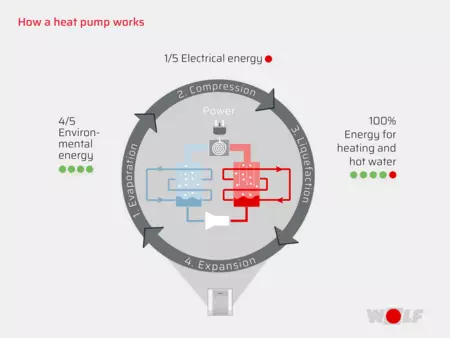
When we talk about monoblock heat pumps, we are actually referring to air-to-water heat pumps in which all components are housed in a single compact housing. This means that the entire refrigerant cycle takes place within the appliance. Therefore, fitters do not need a refrigeration certificate (generally only held by qualified refrigeration technicians) to install these appliances.
If refrigeration piping has to be installed, non-professionals are not permitted to carry out this work because there is a risk of climate-damaging gases escaping into the environment. The effort and expense of installing and maintaining monoblock heat pumps is therefore inherently lower than that of other variants. In principle, the design of monoblock heat pumps makes them suitable for both indoor and outdoor installation.
Find an installer now!
Find competent WOLF heating engineers in your area.
As in all heat pumps, monoblock heat pumps absorb thermal energy from the ambient medium (in this case, air). This is done by the heat exchanger in the appliance’s outdoor coil block. Here, the thermal energy is transferred to the refrigerant. The compressor converts the refrigerant from a liquid to a gaseous state.
This allows the refrigerant to absorb even more thermal energy and both the pressure and temperature of the refrigerant increase. In a second step, the condenser or indoor coil block transfers the heat from the refrigerant to the heating circuit of the heating system or to a buffer cylinder. Cooling causes the refrigerant to return to its liquid state and the cycle begins again.
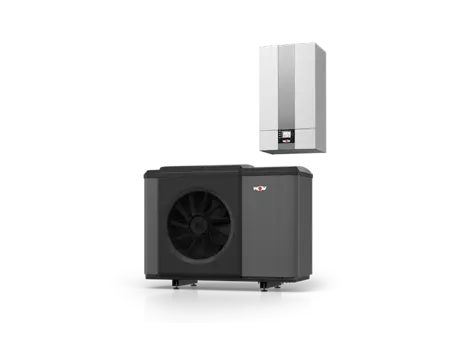
The entire refrigerant circuit is located inside the housing of a monoblock heat pump whether it is installed inside or outside the building. If you opt for a monoblock heat pump installed indoors, you will need to install air ducts in the building to supply and discharge the required ambient air. For outdoor installation, on the other hand, you will need to lay connection lines to the heating system through the walls. The most suitable type of installation usually depends on the space available in the building. Even if you opt for outdoor installation, you will need to allow for space for the associated indoor unit of the appliance. However, the indoor unit is significantly smaller than an indoor monoblock heat pump.
In new buildings, the space required for indoor installation of a monoblock heat pump can be taken into account from the outset. In contrast, outdoor installation is particularly suitable for retrofitting such heat pumps in existing buildings. However, indoor installation is also possible in existing buildings if there is sufficient space in the cellar, for example, or if an oil tank is discarded when modernising the heating system.
Overall, the installation costs for monoblock air-to-water heat pumps are lower because neither installation nor maintenance require a refrigeration certificate. However, the space requirements and weight of a monoblock heat pump are comparatively high, which can make it difficult to find the ideal installation site.
Benefits & drawbacks of monoblock appliances
The working principle of split heat pumps is exactly the same as that of monoblock appliances. The notable difference is that the refrigerant circuit is divided into a compact indoor unit and an outdoor unit. They often also already contain a buffer cylinder for DHW heating or central heating backup. This reduces space requirements in the boiler room enormously as the indoor unit takes up far less space than a monoblock version installed inside.
In split designs, the refrigerant circuit of the air-to-water heat pump is divided into two appliance units. The actual heat generation takes place in the outdoor unit. The outdoor coil block and compressor are installed there. The indoor unit, on the other hand, contains the compressor and the indoor coil block.
The hot gas line system connects both components together. The refrigerant circulates in an additional second line. After the refrigerant is heated, during which it changes to a gaseous state, the thermal energy is transferred to the heating system. It is then routed back to the outdoor unit in liquid form and everything starts all over again.
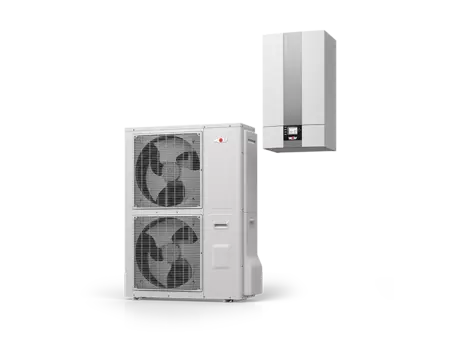
There are several advantages to the appliance components being divided into an indoor unit and an outdoor unit. The outdoor unit is much lighter and more compact than a monoblock heat pump with a comparable output. The noise level in the house is lower if the compressor is situated outdoors.
Inside the building, space requirements are lower for a split heat pump than for the indoor installation of a complete monoblock appliance. Split appliances cannot be installed entirely outside or entirely inside. Therefore, heat pumps of this kind are mainly installed where the available space necessitates a compromise between indoor and outdoor installation.
One disadvantage is that installation and maintenance are more complex and costly as technicians working on the refrigerant line require a refrigeration certificate. If the amount of refrigerant in the appliance exceeds the applicable reference value for the CO2 equivalent, building owners may be subject to an obligatory refrigerant test, which will result in additional costs every year.
Apart from issues concerning space requirements, installation work and the associated costs, the chief issue when comparing monoblock or split heat pumps is that of efficiency. Are there any differences between the efficiency and energy yields of monoblock and split heat pumps? If we look at comparable monoblock and split heat pump models from the same manufacturer, there is barely any difference in efficiency.
Monoblock or split heat pumps: size, weight, sound levels
The efficiency of both types of appliance is similar, but they are very different in size – the footprint and weight of monoblock appliances is always greater. Although monoblock heat pumps can be positioned more flexibly (indoor installation vs. outdoor installation), the size and weight of the monoblock version can slightly increase the complexity and cost of planning, depending on the space available on the property and inside the building.
In terms of noise, there is not much difference between monoblock and split heat pumps as long as their performance is suitably similar. Noise regulations in densely built-up areas can preclude outdoor installation, preventing split appliances from being used at all. A monoblock heat pump, on the other hand, could be installed indoors.
There is no point in making direct price comparisons of the two heat pump types as this does not reflect the whole picture. Monoblock and split heat pumps with similar performance rates and energy efficiency have very different installation costs that depend on the structural conditions on site. Maintenance costs and other elements must also be factored in.

Top advice from WOLF
If you are looking for an efficient heat pump for your existing building or a new build, you should seek in-depth advice. Correct dimensioning and careful planning are crucial for efficient heating. The experts at WOLF will be happy to help you.
Besides practical and financial aspects, the building owner’s preferences also play an important role. If the heat pump is to be installed completely indoors, a monoblock heat pump is the only sensible option. If space conditions both inside and outside force you to make compromises, it is more advisable to choose the split version. The deciding arguments for choosing a monoblock appliance are often the lower installation and maintenance costs due to the elimination of external refrigerant lines. Ultimately, installing a monoblock heat pump is the simplest and most straightforward choice for many building owners, which is what makes these appliances best-sellers.

